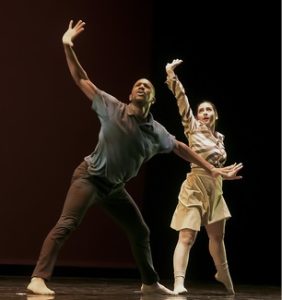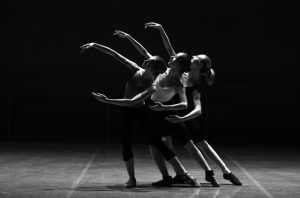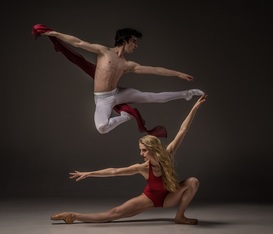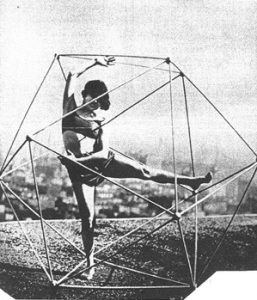2 Elements of Dance
| “A dance, as a work of art, must be constructed as well as a beautiful building…. A dance must have a beginning, development, and climax – just as a building has foundations, walls, and roof.” -Ted Shawn |
What are the Elements of Dance?
The Elements of Dance are the basic building blocks of dance that help us identify and describe movement, assisting in the ability to analyze, interpret and speak/write about dance as an artistic practice. When viewing dance, we want to put into words what we are witnessing by analyzing its most important qualities. The elements of the dance provide us with the tools to do so.
In dance, the body can be in constant motion and even arrive at points of stillness. However, even in stillness, the dancers are inherently aware of themselves. No matter the case, all forms of dance can be broken down into their primary elements: BODY, ENERGY, SPACE, and TIME. To easily remember the dance elements, we use the acronym: B. E. S. T. Dance can be seen as the use of the BODY with different kinds of ENERGY moving through SPACE and unfolding in TIME.
Let’s take a quick look at the elements of dance before we dig in further.
Watch This
Randy Barron, Teaching Artist on the Kennedy Center’s National Roster, made this video to explain the Elements of Dance:
Body
The body is the dancer’s instrument of expression. When an audience looks at dance, they see the dancer’s body and what is moving. The dance could be made up of a variety of actions and still poses. It could use the whole body or emphasize one part of the body. Exploring body shapes and movement actions increases our awareness of movement possibilities.

Body Shapes
The choreographer who is designing a dance may look at their dancers as sculpture. They choose shapes for the dancers to make with their bodies. These can be curved, straight, angular, twisted, wide, narrow, symmetrical, or asymmetrical. These shapes can be geometric designs, such as circles or diagonals. They could make literal shapes such as tree branches or bird wings. They can also make conceptual shapes (abstract) such as friendship, courage, or sadness. Sometimes a choreographer emphasizes the negative space or the empty area around the dancers’ bodies instead of just the positive space the dancer occupies. Look at the positive and negative spaces in Fig 2.

Body Moves/Actions
Dance movements or actions fall into two main categories:
Locomotor: traveling moves like walk, run, jump, hop, skip, leap, gallop, crawl, roll
Nonlocomotor: moves that stay in place like melt, stretch, bend, twist, swing, turn, shake, stomp
Below is an example of body movements and shapes by modern dance choreographer Paul Taylor.
Watch This
Excerpt from Paul Taylor’s Esplanade. Observe how the dancers use locomotor movement as they run, form circular formations, and create lines in space.
Body Parts
Each part of the body – head, shoulders, elbows, hips, knees, feet, eyes, etc.- can move alone in isolation or in combination with each other.
Watch This
Here the LSU Golden Girls perform in a pre-football game ritual at Tiger Stadium. In this routine the dancers begin with arm isolations, add some head isolations, and finish with the iconic high kicks of a chorus line.
In the next video, dancers are participating in the GAGA technique developed by Israeli Ohad Naharin. In this movement language, dancers are directed to listen to their inner sensations to elicit physical responses; movement. Notice how the dancers are integrating the entire body to create fluid and successive movement.
Check Your Understanding
Energy
An exploration of “how” a movement is done rather than “what” it is, gives us a richer sense of dance as an expressive art. A dancer can walk, reach for an imaginary object and turn, making these movements look completely different by changing the use of energy. For example, anger could be shown with a loud quick walk, a sharp reach, and a strong twisting turn. Happiness could be depicted by using a delicate gliding walk, a gentle reach out, and a smooth light turn. Energy is what brings the dancer’s intent or emotion to the audience. The element of energy is sometimes called efforts or movement qualities.
Dancer and movement analyst Rudolf Laban broke it down into four efforts, each of which is a pair of opposites:
- Space – direct or indirect use of space: When the dancer is paying attention to the use of space they can be direct, single-focused, and targeted in their use of space. Conversely, they can be indirect, multi-focused, and aware of many things in the space around them.
- Weight or force (strong or light use of weight) The dancer can emphasize the effort or use of force by fighting against it, throwing their weight and strength into movements. The opposite is using a yielding, light sense of weightlessness in their movements.
- Time – sudden or sustained use of time – (not to be confused with tempo) the dancer’s use of time can be reflected in their movement. It can appear hurried, as though fighting against time. Conversely, the dancer can have a relaxed attitude toward time as though they have all the time in the world.
- Flow – bound or free use of the flow of movement – When the dancer’s flow is bound up, they can appear to be careful and cautious, only allowing small amounts of flow. The opposite is when the dancer appears to throw the movement around without inhibition, letting the movement feel carefree.
Another way we can define energy is by looking at the movement qualities. Movement qualities are energy released during various time spans to portray distinct qualities. There are six dynamic movement qualities.
- Sustained : slow, smooth, continuous
- Percussive : sharp, choppy, jagged
- Swinging : swaying, to and fro, pendulum-like
- Suspended : a moment of stillness, the high point, a balance
- Collapsed : fall, release, relax
- Vibratory: shake, wiggle, tremble
Notice the kinds of energy the dancers are displaying in the examples below.
In the first video the dancers are using efforts of direct, strong, sudden and bound movements. In terms of movement qualities, the dancers are using percussive, vibratory, and moments of collapse.
Watch This
Hip Hop dance crew Kaba Modern uses the efforts of direct, strong, sudden, and bound movements. In terms of movement qualities, the dancers use percussive and vibratory movements, and moments of collapse.
In the National Opera of Ukraine’s prelude from Chopiniana, the dancers are using efforts of light and free. The movement qualities are sustained and suspended.
Check Your Understanding
Space Let’s look at where the dance takes place. Is the dance expansive, using lots of space, or is it more intimate, using primarily personal space? An exploration of space increases our awareness of the visual design aspects of movement.
- Personal Space: The space around the dancer’s body can also be called near space. A dance primarily in personal space can give a feeling of introspection or intimacy.
- Negative Space/Positive Space: Sometimes, a choreographer emphasizes the negative space or the empty area around the dancers’ bodies instead of just the positive space the dancer occupies. Look at the positive and negative space in the photograph below.
- General Space: The defined space where the dancer can move can be a small room, a large stage, or even an outdoor setting.
- Levels: Dancers use a variety of levels. High movements can reach upward using jumps, leaps, or when lifting each other. A middle level move is generally a move that takes place between the height of the dancer’s shoulders and knees. Low level moves can include sitting, kneeling, sinking to the ground, rolling, or crawling.

Fig. 4. photos/agility-ballet-dancing-athlete-1850711/ – First found on Mar 28, 2021 Filename: agility-1850711_1280.jpg (1280 x 1097, 113.2 kB) - Directions: Dances made for the camera often have the performers facing forward as they dance, but dancers can also change directions by turning, going to the back, right, left, up, or down.
- Pathways or Floor Patterns: Where the dancer goes through space is often an important design element. They can travel in a circle, figure eight, spiral, zig-zag, straight lines, and combinations of lines.
- Range: Movements or shapes can be near reach, mid-ranged, or far reach. Range is associated with one’s kinesphere. Kinesphere is the immediate area surrounding the body and is described as a three-dimensional volume of space. Imagine a bubble around the dancer’s body, with their arms and limbs extended to their fullest extent in every possible direction without moving from a fixed spot. This is considered a personal kinesphere. Movement occurs in a person’s and includes near reach (movement that is close to the body, small or condensed), mid-reach (movement that is neither near not far, but comfortably in the middle ), and far reach (large and expansive movement).

Fig 5. Français : Épreuve gélatino-argentique 1925 24,5 x 21 cm 18 May 2017 Mathildemultiple. CC Attribution-Share Alike 4.0 International license. - Relationship: Dancers can explore the relationship between different body parts; the relationship of one dancer to another dancer or a group of dancers; or the relationship to a prop or to objects in the dance space.

Fig. 6. Egyptian Modern Dance Theatre in performance “devil hope.” 27 September 2016, 21:43:59 Esraa abd el khalla. CC Attribution-Share Alike 4.0 International license.
Watch This
Excerpt from George Balanchine’s ballet Apollo. Notice the interlocking of circles of the dancers’ arms and the straight lines made by the dancers’ legs.
In this next video, notice various floor patterns such as circular pathways and straight lines that are made by the group of dancers. Observe the dancers’ use of gestures that go from near to far reach from personal space to filling the general space. The choreography also uses levels from low to high.
Check Your Understanding
Time
Dance is a time art; movement develops and reveals itself in time. Adding a rhythmic sense to movement helps transform ordinary movement into dance and informs when the dancer moves.
- Pulse: The basic pulse or underlying beat
- Speed (tempo): Fast, moderate, slow
- Rhythm Pattern: A grouping of long or short beats, accents or silences
- Natural Rhythm: Timing which comes from the rhythms of the breath, the heartbeat, or natural sources like the wind or the ocean.
- Syncopation: Accents the off-beat in a musical phrase.
Compare the different uses of Time in the two videos below.
In the first video, the dancers have no musical accompaniment and use their breath to initiate movement and cue each other for the timing. Their movement is also slow to moderate tempo and imitates the natural rhythm of the ocean.
Watch This
Excerpt from Modern Dance choreographer Doris Humphrey’s Water Study. In this video, the dancers have no musical accompaniment and use their breath to initiate movement and cue each other for the timing. Their movement is also slow to moderate tempo and imitates the natural rhythm of the ocean.
Promo clip of Step Afrika!, the dancers are creating rhythm patterns with body percussion. There is an emphasis on syncopation and varying tempos with accents.
Summary
All dance forms share foundational concepts known as the Elements of Dance. The Elements of Dance are overarching concepts and terminology that are useful when observing, creating, analyzing, and discussing dance. Dance can be broken down into its primary elements : Body, Energy, Space, and Time. It can be easily recalled through the acronym B.E.S.T.
The Body is the mobile instrument of the dancer and helps inform us what is moving. The Body category includes shapes, actions, whole body, and part body movements. Energy is how the body moves. When speaking about energy, we can refer to effort or movement qualities. Space is where movement occurs and includes personal and general space, levels, directions, pathways and floor patterns, various sizes of movements, range of movement, and relationships. Time is when the dancers move. The Time category includes pulse, speed, rhythmic patterns, natural rhythm, and syncopation.
As an observer of dance, it can be easy to allow our biases to influence how we perceive dance. By using dance vocabulary and stating what we observe, we can be more objective in our discussions of dance. Using the Elements of Dance, we can view dance through an unbiased lens to consider its structural elements to deepen our understanding and appreciation of dance as an art form.
Check Your Understanding
1. Try making shapes that depict literal and abstract concepts. Some examples of literal shapes might be a flower, a seashell, or a rainbow. Some abstract shapes might be circles, diamonds, or even concepts such as friendship, heroism, or depression.
2. Make a short (10 second) dance phrase and perform it twice with two different types of energy.
3. On paper, draw a map with a continuous pathway without lines overlapping. After mapping your pathway, try adding locomotor movement on various levels that compliments your pathway design.
4. Make a sentence introducing yourself and your favorite food. For example: “Cissy Whipp likes chips and guacamole.” or “Vanessa Kanamoto likes grilled shrimp.” Now try clapping the rhythm your sentence makes. (Notice how the two examples have very different rhythms.) Create a movement pattern that matches the rhythm pattern of your sentence. Practice until you can repeat it four times in a row.
Check Your Understanding
Resources:
The Elements of Dance website from Perpich Center for Arts Education in
partnership with University of MN Dance Program https://www.elementsofdance.org/
The body is the dancer’s instrument of expression and is the first element of dance. The Body is the mobile instrument of the dancer and helps inform us what is moving.
The element of Energy is an exploration of how a movement is done rather than what it is, and gives us a richer sense of dance as an expressive art. When speaking about energy, we can refer to effort or movement qualities.
The element of Space refers to where movement occurs and includes personal and general space, levels, directions, pathways and floor patterns, various sizes of movements, range of movement, and relationships.
The element of Time refers to when the dancers move and how the movement uses time. The Time category includes pulse, speed, rhythmic patterns, natural rhythm, and syncopation.
refers to body designs that use the same shape on both sides of the body, creating balance.
body designs use different shapes from one side of the body to the other, creating an unbalanced look.
is the empty area around the dancers’ bodies.
is the area of space the dancers’ bodies occupy.
movements are movements that travel in space.
movements are those performed in place.
Weight or force (strong or light use of weight) The dancer can emphasize the effort or use of force by fighting against it, throwing their weight and strength into movements. The opposite is using a yielding, light sense of weightlessness in their movements.
The element of Flow refers to how much effort is exerted by a dancer to control movement. Bound flow has a "fighting-like" quality that is performed in a restrictive manner that is easy to stop. Free flow has a "relaxed-like" quality that is difficult to stop.
movements performed in a slow and smooth continuous rate
refers to attack-like quality to produce sharp, sudden, and abrupt movements
movements have a pendular or circular-like quality.
movements occur at the peak of a movement defying gravity before succumbing to it.
is a release of energy from the body.
movements use rapid and repeated bursts of energy.
is the defined space in which the dancer can move.
describe the various heights movement can occur in space.
describe the facing of a performer as they dance or pose. It can be forward, backward, right, left, up, down, or they can also change directions by turning.
are sometimes called Floor Patterns and describe where the dancer goes through space, i.e., curved, straight, circular, diagonal, etc.
of motion refers to how much or how little personal space is used when dancing or posing.
is the immediate area surrounding the body and is described as a three-dimensional volume of space.
refers to the proximity of the dancer to others or to objects in the dance space (in front, behind, over, under, connected, apart).
the basic pulse or underlying beat of movement and/or music.
also known as tempo, describes the pace of the music or movement.
A grouping of long or short beats, accents or silences.
Timing which comes from the rhythms of the breath, the heartbeat, or natural sources like the wind or the ocean.
accents the off-beat in a musical phrase.
describe where the dancer goes through space, i.e., curved, straight, circular, diagonal, etc.

